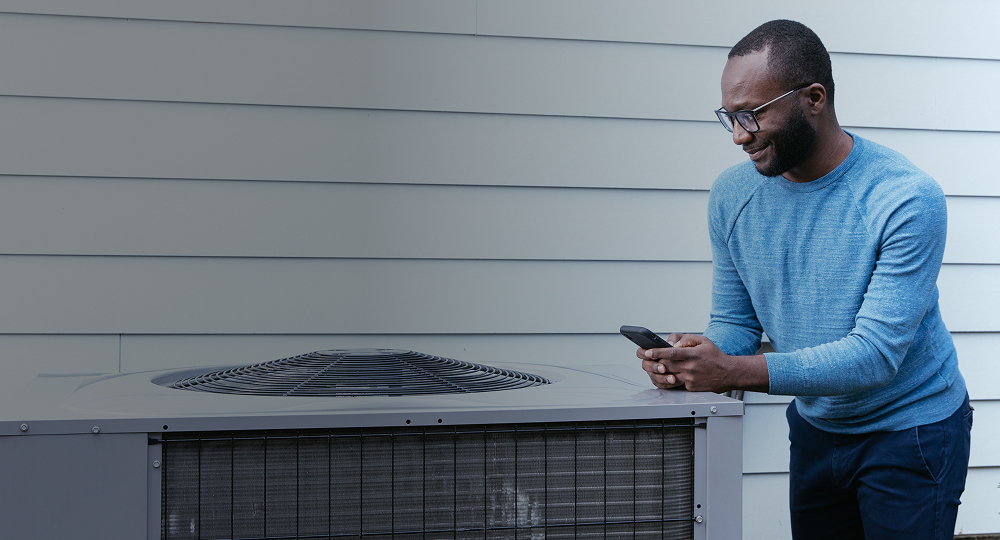Avoiding air sealing and duct system maintenance? It’s costing you money.

For most things, the better you take care of it, the longer it will last. Cars need their oil changed, your favorite sweater needs mending, and homes need to be weatherized and duct systems maintained. That’s not only because air sealing and duct system maintenance help maintain good indoor air quality and a comfortable home, but because they also support the efficiency of your HVAC system.
When you stay on top of these smaller home energy maintenance tasks, it’s like changing your car’s oil. You avoid the expense and stress of repairing or purchasing a new car engine just by taking care of the oil. When you air seal your home and maintain your duct system, you take unnecessary stress off your HVAC system, lowering your monthly energy bill and avoiding the financial headache of repairing or replacing a very expensive piece of equipment that you most likely won’t want to go without. Let’s take a closer look at these important, but often overlooked, areas of home maintenance.
What is air sealing?
Air sealing, also sometimes referred to as weatherization, is the process of identifying and sealing any gaps or cracks inside your home or in your home’s exterior where air can sneak in or out. It’s like your home’s very own bouncer, one that blocks the riff raff (outside air and pollutants) from entering so that all the people inside can continue to have a good time!
These gaps and cracks may seem like no big deal, but they can actually have a really negative impact on your energy bill each month. Heat always moves from hot to cold. So when your HVAC system is producing all that warm cozy heat in the winter, those gaps and cracks are letting it right out the literal window. That forces your HVAC system to turn on more frequently to maintain your preferred indoor temp, which uses more energy and drives your energy bill up. Yikes. The reverse is true in the summer. Hot air from the outside will sneak its way into your home, causing the indoor temperature to rise more quickly — and you know what happens from there.
Let’s say your average monthly energy bill is $150, or $1,800 per year. Just by air sealing your home, you could save around $180! Plus, your HVAC system won’t have to work as hard, which is going to extend its overall lifespan. Now let’s dig a little deeper.
The 4 main reasons why you should air seal your home.
It’s a safe bet that pretty much all homes (even brand-new builds) could benefit from air sealing. The goal isn’t to have a completely airtight home, but rather to control how air enters and exits your home. Air sealing:
- Lowers your energy bill.
- Increases your indoor comfort.
- Blocks outside pollutants.
- Improves the functionality of your insulation, duct system and HVAC system.
Combine our home energy rebate on air sealing with federal tax credits to increase your total savings.
5 signs that your home needs to be air sealed.
If you’ve never taken a walk around the exterior of your home or really investigated the nooks and crannies of the inside of your home, then your home needs to be air sealed. If there was a different president in office the last time your air sealed your home, then your home needs to be air sealed. Here are some other indicators you can look for:
- Visible daylight around doors or windows.
- Visible gaps or cracks around plumbing fixtures and electrical wires.
- Drafty rooms or cold spots.
- Difficulty maintaining your desired temperature.
- Higher than normal energy bills.
The most common places around your home for air leaks.
While some areas of your home might seem like obvious places for air leaks, like around doors and windows, there are more places than you might think:
- Around doors and windows.
- Around pipes and drains.
- Around electrical sockets and light switches.
- Around recessed lighting.
- Floorboards and floor vents.
- Floors, ceilings and walls.
- Crawl spaces, attics and basements.
- Unheated garages.
Professional home air sealing vs. DIY home air sealing.
Everyone’s budget, schedule and confidence with DIY tasks is different. So whether you’re able to hire a professional to air seal your home or would prefer to go the DIY route, the impacts will be positive!
In general, some areas of a home are easier to air seal than others. Take a stab at DIY weatherization with a few simple air sealing tools, like weatherstripping, door sweeps, caulk, a caulk gun, and some spray foam. These methods are usually simple, straightforward and very affordable. Plus, you can even get a tax credit for materials you use to weatherize your home. Remember, YouTube is your best friend!
If DIY isn’t your thing or you’re hoping to reach areas of your home where your DIY skills just won’t go, then go with a professional. They’re going to be able to get those tough-to-reach spots in your crawl space or attic, around recessed lighting and plumbing or more complex issues around doors and windows. Use our Quality Contractor Network to find licensed and insured contractors near you. Vetted by TVA and trained to meet our project quality standards, Quality Contractor Network members can complete your air sealing job and give you direct access to our air sealing home energy rebate or any financing support you might need.

The role of your home’s duct system.
Now that we’ve tackled air sealing, let’s talk about your home’s duct system. Like air sealing, it’s another one of those unsung home energy heroes pulling far more weight than you realize. Your home’s duct system works hand-in-hand with your HVAC system. So while your HVAC system is off creating the heating and cooling necessary to get your home to its desired temperature, your duct system is responsible for actually moving that warm or cool air around your home. The HVAC and duct systems also work together to maintain indoor air quality, regulating your home’s temperature and humidity while also removing pollutants from the air you breathe inside your home. Your duct system has a big job, so ensuring that it operates at peak efficiency is a priority.
The 4 main reasons why you should seal and insulate your duct system.
You can lose 20-40% of your heating and cooling through air leaks and poor duct insulation. Sealing, insulating or replacing ductwork comes with a number of benefits. These simple fixes can:
- Lower your energy bill.
- Protect the air you breathe.
- Increase your indoor comfort.
- Put less wear and tear on your HVAC system.
Plus, TVA EnergyRight offers a $300 rebate on duct system upgrades so that you can enjoy a more energy efficient home at an affordable price.
6 Signs your duct work needs maintenance.
For the most part, your home’s duct work won’t be visible to you. But just because you can’t see a crack or feel a leak doesn’t mean your home won’t give you some helpful signs that maintenance needs to be done. Be on the lookout for:
- Higher than normal energy bills.
- Difficulty maintaining your desired temperature.
- Uneven heating and cooling.
- Noticeable dustiness.
- Whistling or whooshing sounds when your HVAC runs.
- Dirt, dust, mold or condensation around air vents.
Professional duct system maintenance vs. DIY duct system maintenance.
While it’s hard to deny the magical powers of duct tape, unless you really know what you’re doing with your duct work, leave maintenance to the professionals. We recommend getting your ductwork cleaned by a professional every two to five years — more frequently if you have furry friends or household members whose health could be affected by negative changes in indoor air quality. During a professional cleaning:
- Buildup of dirt, dust and mold is removed from the supply and return ducts and registers, diffusers and grilles, system coils, drip and drain pan, fan motor and HVAC system cabinetry.
- Gaps or cracks causing air leaks are identified and repaired.
- The exterior vent of your dryer is cleaned. (Important for preventing fires!)
If concerning amounts of mold are identified, your professional should flag that for you. Not all mold is created equal, and you may need to bring in a different kind of professional to evaluate the situation.
Even though we recommend using a professional to clean your entire duct system, there are still some easy maintenance tasks you can do yourself that will help maintain the integrity of your ductwork and HVAC system. Here’s what to do:
- Change your air filter at least once every three months.
- Brush off dust and dirt from your air vents and registers.
- Run your bathroom exhaust fan while you shower to prevent moisture buildup and mold.
Protect your HVAC system. Air seal your home and schedule duct system maintenance.
An ounce of prevention is worth a pound of cure, especially if it means you can avoid the expensive task of replacing your HVAC system earlier than you anticipated. Air sealing your home and maintaining your duct system pays off. Increase your home’s energy efficiency, lower your energy bills and enjoy a more comfortable home year round.
Skip the hassle of scrolling through pages of contractor search results. All Quality Contractor Network members are vetted by TVA and trained to meet our project quality standards. Plus, we offer a free job inspection by a TVA-certified Home Energy Advisor for added peace of mind. Search the Quality Contractor Network for free and find TVA-vetted contractors near you.
Find a TVA-vetted contractor and get home energy rebates today.




